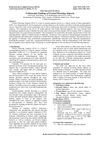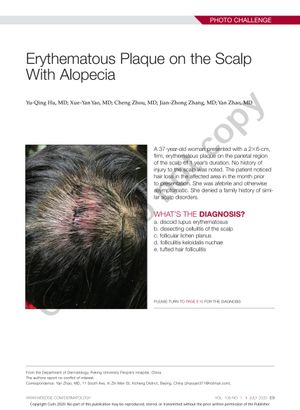TLDR The woman has a scalp condition causing hair loss.
A 37-year-old woman presented with a 2×6-cm, firm, erythematous plaque on the parietal region of the scalp, which had been present for 1 year. She experienced hair loss in the affected area a month before seeking medical attention. She had no history of scalp injury, was afebrile, asymptomatic, and had no family history of similar scalp disorders. The differential diagnosis included discoid lupus erythematosus, dissecting cellulitis of the scalp, follicular lichen planus, folliculitis keloidalis nuchae, and tufted hair folliculitis.
13 citations
,
June 2011 in “PubMed” The patient improved significantly after treatment, with only one small scar remaining.
9 citations
,
January 2004 in “Journal of dermatological treatment” Rifampicin effectively treated tufted hair folliculitis with no relapse after one year.
226 citations
,
February 1999 in “British Journal of Dermatology” Folliculitis decalvans and tufted folliculitis are related, and a new treatment with rifampicin and clindamycin is effective.
 1 citations
,
July 2022 in “Journal of Cosmetic Dermatology”
1 citations
,
July 2022 in “Journal of Cosmetic Dermatology” Inflammatory complications are rare after hair transplants but can happen months later, and checking for skin conditions before surgery is important.
 1 citations
,
July 2020 in “Benha Journal of Applied Sciences”
1 citations
,
July 2020 in “Benha Journal of Applied Sciences” Trichoscopy is useful for diagnosing Frontal Fibrosing Alopecia.

Low-dose oral isotretinoin improved hair loss and facial bumps in patients with a specific type of hair loss.
18 citations
,
January 2013 in “Dermatology Online Journal” Trichofolliculoma is a rare skin bump on the face or scalp.
 5 citations
,
October 1988 in “Clinics in Dermatology”
5 citations
,
October 1988 in “Clinics in Dermatology” Minoxidil promotes hair growth but exact mechanism is unknown.





